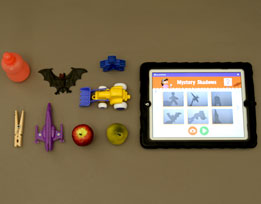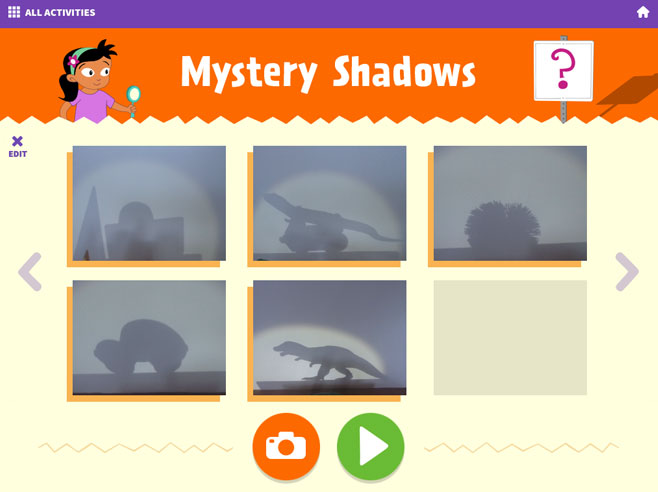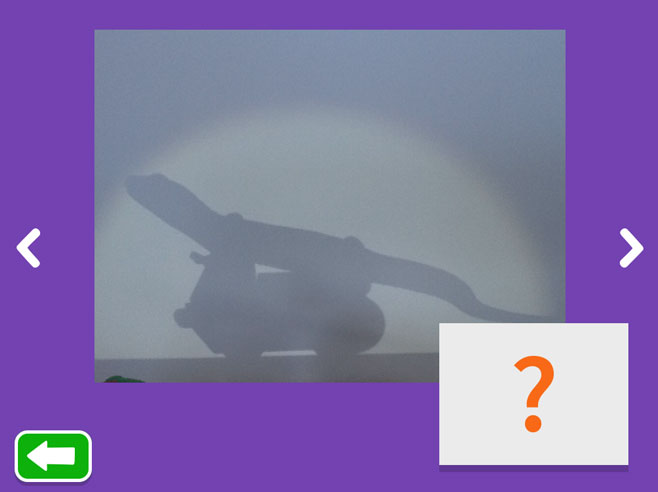Children share a digital guessing game with their classmates based on the mystery shadows photographs they staged using the Mystery Shadows tool.
Materials

- Shadows Journal app on 4 iPads (those used during Guided Small Group to take the photos)
- Circle Time: Projector (if available)
- Optional: props children used to make Mystery Shadows photos during Guided Small Group
Preparation
- In the Shadows Journals app on each iPad, identify one or two Mystery Shadows photo pairs to include in the Circle Time: Wrap-Up game.
- If using, set up a projector to display the iPad.
- For Lesson 7, you may want to display the props used to make the mystery shadows.
Directions: Lesson 3
Digital Learning Center
- Invite children to explore the Mystery Shadows game in pairs or individually. Observe how children approach each of the photos. Use prompts such as those used during earlier group shadow explorations to engage children in science and math talk. Possible discussion ideas:
- How many shadows do you see? How many objects made the shadow?
- How was the shadow made?
- What object(s) do you think made these shadows? Let’s find out.
- Support children in thinking about cause and effect as they solve each level’s challenges, noting how shadows are made, can be made to appear and disappear, and can change shape, position, and size.
- Encourage children to listen to and build on each other’s ideas.
Circle Time: Wrap-Up
In earlier Guided Small Group activities, children staged and captured photos with the Mystery Shadows Photos tool. In this Circle Time: Wrap-Up activity, the class plays the Mystery Shadows game in the digital Shadows Journal with shadow photos taken by each group.
- If you are including the props from the Mystery Shadows Photos activity, display them for the class. Invite children to name the objects. This will be particularly helpful for combined shadow photos.
- Attach the first iPad to the projector (if available) and open to the Mystery Shadows gallery. Tap the photo that you have selected for the first item in the game.
- Listen to Nico’s question, What do you think made this shadow? Invite children to share their guesses. Have them support their ideas by asking them, Why do you think that?
- Model how to provide evidence to support an opinion by doing a “think aloud.” For example, I think that might be a shadow of a toy bear because I see its two round ears and its front legs.
- Show several props, including the object(s) that made the shadow. Encourage children to count features on each object, then count the features on the shadow. Are they the same or different?
- Can children figure out which of these props were used to make a specific shadow photo? Can they count the number of ears and legs?
- Can they explain why they think a particular prop made the shadow?
- Can they explain why they think a particular prop did NOT make the shadow?
- When children have shared and responded to each other’s guesses, summarize the ideas that you have heard; for example: Some people think this is the shadow of a toy bear because it has two round ears, and some people think it’s the shadow of a toy monkey because monkeys also have round ears like this.
- Tap the square with the question mark to reveal the photo of the object that made the shadow.
- Tap the back arrow in the lower left corner to return to the gallery, and tap the next mystery shadow you have selected.
- Repeat with the other iPads to view mystery shadows by the other small groups.
Directions: Lesson 7
Digital Learning Center
- Invite children to explore the Mystery Shadows game in pairs or individually. Observe how children approach each of the shadow photos, and use prompts such as those used during earlier group shadow explorations to engage children in science and math talk. Possible discussion ideas:
- How many shadows do you see? How many objects do you think made the shadow?
- How was the shadow made?
- What object(s) do you think made these shadows? How do you know? Let’s find out.
- Support children in thinking about cause and effect as they solve each challenge, noting how shadows are made, can be made to appear and disappear, and can change shape, position, and size.
- Encourage children to listen to and build on each other’s ideas.


